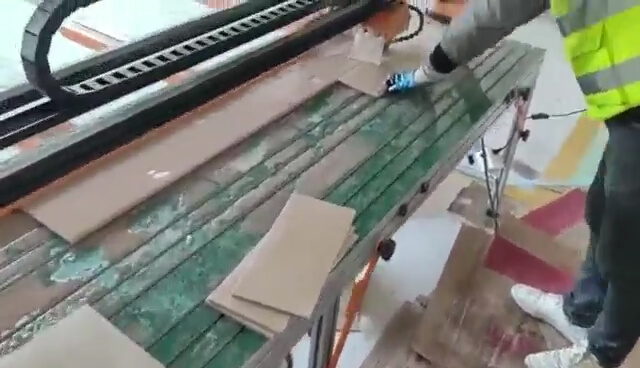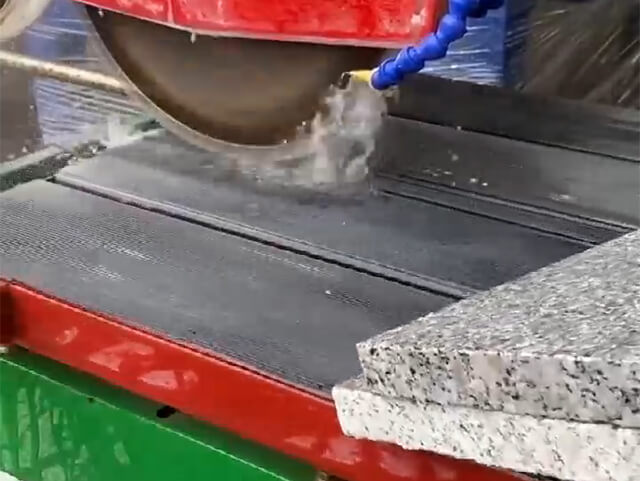Author:Dafon Kerbstone Machine FROM:Stone Machine Manufacturer TIME:2024-08-13
You'll need the right tool for the job to cut tiles effectively. Here are the most common options:
Wet Tile Saw: This versatile tool uses a water-cooled diamond blade to cut through various tile types, including ceramic, porcelain, glass, and natural stone. It's ideal for straight cuts and many angled cuts.
Manual Tile Cutter: Best for smaller ceramic and porcelain tiles, this tool scores and snaps the tile for a clean, straight break.
Angle Grinder: Equipped with a diamond blade, an angle grinder offers flexibility for various cuts, including curved lines and irregular shapes. It's also suitable for thicker tiles like stone.
Tile Nippers: These make small adjustments and create intricate shapes in ceramic and porcelain tiles.
Rotary Tool: This is useful for detailed work and small cuts, such as cutting holes or curves in tiles. It typically uses a diamond or carbide bit.
Choosing the right tool depends on the type of tile, the desired cut, and your project's complexity.

Ceramic tile is generally best cut using a wet method, specifically with a wet tile saw. Here’s why:
Reduced Dust: The water cools the blade and reduces the amount of dust generated, making the process cleaner and safer, especially when cutting inside.
Cleaner Cuts: Wet cutting helps minimize chipping and cracking, resulting in smoother, more precise cuts.
Blade Longevity: The water cools the diamond blade, reducing wear and tear, which extends the blade's life.
Dry cutting is possible with tools like a manual tile cutter or an angle grinder, but it may result in more chipping, more dust, and shorter blade life. For best results, especially with ceramic tiles, wet cutting is recommended.

To cut ceramic tile without cracking it, follow these steps:
Use the Right Tools:
Wet Tile Saw: This is the most effective tool for making clean, precise cuts without cracking. The water reduces friction and heat, which helps prevent cracking.
Manual Tile Cutter: Ideal for straight cuts, this tool scores the tile and allows you to snap it along the score line cleanly.
Diamond Blade: Whether on a wet saw, angle grinder, or rotary tool, using a diamond-coated blade ensures a smoother cut with less risk of cracking.
Mark Your Cut Line:
Use a pencil, marker, or tile scribe to mark the cut line clearly on the tile.
Score the Tile:
For manual cutters, score the tile lightly but firmly along the marked line. Ensure the scoring wheel or blade cuts deeply enough to weaken the tile along the line but not too deep to cause stress that might crack the tile.
Cut Slowly and Steadily:
Whether using a wet saw or manual cutter, go slowly to maintain control. Avoid applying excessive pressure, as this can cause the tile to crack.
Use Proper Technique:
On a wet tile saw, guide the tile steadily through the blade, ensuring it remains flat and aligned with the cut.
With a manual cutter, after scoring, apply even pressure on both sides of the tile to snap it cleanly along the scored line.
For intricate cuts with an angle grinder or rotary tool, make multiple passes with light pressure rather than trying to cut through the tile in one go.
Support the Tile:
Ensure the tile is well-supported, particularly near the cut line, to prevent vibrations or movement that can cause cracking.
Smooth the Edges:
After cutting, use a tile file, rubbing stone, or sandpaper to smooth out any rough edges, which can help prevent small cracks from spreading.
Following these steps should help you cut ceramic tile cleanly and accurately without cracking it.

If you don't have a wet tile saw, you can use the following tools as alternatives to cut ceramic tiles
Manual Tools:
Manual Tile Cutter: Best for straight cuts on smaller ceramic and
porcelain tiles.
Tile Nippers: Used for small adjustments or creating irregular shapes in ceramic and porcelain tiles.
Power Tools:
Angle Grinder with Diamond Blade: Versatile for various cuts, including curved lines and irregular shapes, but generates dust and requires more skill.
Rotary Tool with Diamond Bit: Ideal for small, detailed cuts and creating holes.
Important Considerations:
Tile Type: The type of tile will influence the best tool choice.
Cut Complexity: Straight cuts are easier with a manual tile cutter, while intricate shapes might require an angle grinder or tile nippers.
Dust and Safety: Be aware of dust generation, especially with power tools. Wear appropriate safety gear.
Nofity: These alternatives often produce less precise cuts compared to a wet tile saw. For larger or more complex projects, renting or purchasing a wet tile saw might be more efficient and produce better results.
tile cutter for porcelain tile
Yes, you can cut porcelain tile with a manual tile cutter, but there are some important considerations to keep in mind:
Principle:
A manual tile cutter is designed to score the surface of the tile with a tungsten carbide or diamond-coated wheel, then snap the tile along the scored line.
It’s a straightforward tool to use, especially for making straight cuts.
advantages:
Straight Cuts: A manual tile cutter is effective for making straight cuts on porcelain tiles.
No Electricity Required: It's a simple, portable tool that doesn’t need electricity, making it convenient for use in various locations.
Quick and Easy: For straightforward, straight cuts, it’s a fast and easy solution.
Less Mess: Unlike saws, a manual tile cutter doesn’t create dust or require water.
disvantages:
Limited to Straight Cuts: It’s not suitable for curved or intricate cuts. For those, you’d need a different tool like an angle grinder or a wet saw.
Risk of Chipping: Porcelain is very hard and dense, so there’s a higher chance of chipping the edges, especially if the tile is thick or if the cutter isn't of high quality.
Not Ideal for Large or Thick Tiles: If the porcelain tiles are very large or thick, a manual tile cutter may struggle to cut them cleanly. In such cases, a wet tile saw would be more effective.
Tips for Success:
Use a High-Quality Cutter: Ensure that the manual tile cutter is of good quality and that the scoring wheel is sharp and suitable for hard materials like porcelain.
Score Firmly and Evenly: Apply even pressure while scoring to create a clean line.
Snap Carefully: After scoring, snap the tile with steady pressure. Doing this too forcefully or unevenly can cause the tile to crack or chip.
Conclusion:
While a manual tile cutter can be used to cut porcelain tiles, especially for straight cuts, it’s crucial to use a high-quality cutter and to work carefully to avoid chipping. For more complex cuts or thicker tiles, a wet tile saw is generally a better option.

When choosing a tile cutter for porcelain tiles, you’ll want to select a high-quality, robust tool that can handle the hardness and density of porcelain. Here are the key types of tile cutters and what to look for:
Manual Tile Cutter
A manual tile cutter is a practical choice for straight cuts on porcelain tiles.
Key Features to Look For:
Strong Frame and Base: The cutter should have a sturdy frame and base to handle the pressure needed to score and snap porcelain tiles.
Carbide or Diamond-Coated Scoring Wheel: A durable scoring wheel is essential for making a clean, deep score line on hard porcelain.
High Cutting Capacity: Ensure the cutter can handle the size and thickness of your tiles. Look for one with a high cutting length and thickness capacity.
Smooth Gliding System: A cutter with a smooth, stable rail system helps ensure that the scoring wheel moves evenly across the tile, reducing the risk of chipping or uneven cuts.
Dual Rails: Dual guide rails offer better stability and precision during cutting.
Recommended Models:
Wet Tile Saw
If you need to make curved cuts, cut thicker tiles, or require absolute precision, a wet tile saw is the best option.
Key Features to Look For:
Diamond Blade: A wet tile saw equipped with a high-quality diamond blade is essential for cutting porcelain smoothly.
Water Cooling System: The water helps keep the blade cool, reduces dust, and minimizes the risk of cracking or chipping the tile.
Adjustable Fence and Bevel Capacity: These features allow for more versatility in making different types of cuts, such as angled or beveled edges.
Powerful Motor: A motor with sufficient power (typically 1 HP or more) ensures that the saw can cut through dense porcelain tiles without bogging down.
Conclusion
For straight cuts on porcelain tiles, a high-quality manual tile cutter will serve you well. If your project requires more complex cuts or you are working with thicker or larger tiles, a wet tile saw with a diamond blade is the better choice.